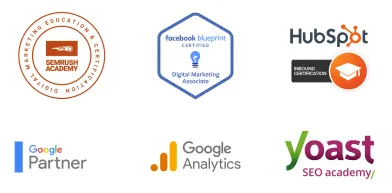TO LEARN IS TO GROW
Learning Center
We do our research and publish our results. Should probably call this the Growing Center.


The New Norm of Digital Marketing Strategy for Manufacturing Industry
The manufacturing industry is uniquely susceptible to disruptive events, such as globalization, economic recession, and just recently the global pandemic and the subsequent social distancing that has amplified our reliance on and use of the internet. Hence, to make sure that your digital marketing strategy remains relevant, it should adapt to the new online activities and trends.
According to Business Insider report, the long-term impact of COVID-19 will ripple for years, with experts warning that the manufacturing industry could suffer a huge decline in consumer demands. This new norm may particularly spell disaster to companies that manufacture non-essential commodities such as clothing, jewelry, consumer electronics, entertainment, etc.—unless they are able to adapt to the crisis and its subsequent effects.
One way to adapt to the substantial impact of the coronavirus pandemic is to design a digital marketing strategy that must be in line with the new norms and the new consumer sentiments and behavior.
Shift Everything Online
According to COVID-19 and E-commerce report published by the United Nations Conference on Trade and Development, the pandemic has changed how consumers from developed and emerging markets use digital solutions and e-commerce. To put this into perspective, during the first few months of lockdowns and shut downs, total internet hits jumped between 50% and 70%.
The report, which covered multiple countries including China, Switzerland, Brazil, Germany, Italy, South Korea, South Africa, and Turkey, also suggests that changes in online activities are likely to continue even long after the pandemic has been well under control.

Create Human Connections Through Popular Communication Platforms
The new norms of digital marketing strategy, according to the report, particularly benefitted communication platforms like Instagram, WhatsApp, and Facebook Messenger, which are all owned by Facebook.
These aforementioned communication platforms are particularly helpful in re-engaging with your potential customers provided that you deliver and share valuable content. Furthermore, they can help you generate high-quality sales leads and reach your target audience in the most “intimate” way possible.
To give an impression that you are a customer-focused business, make sure that you reply to people when they interact with your content.
By truly engaging with the community and not just copy-pasting some spiels—which people can easily detect—they will remember you longer. Take note that brand recall is a recipe for success in times when everyone is bombarded with ads, information, and other white noise on the Internet.
Harness The Power of Facebook Ads
With the proliferation of paid advertising, Facebook Ads stands out from the rest due to its ability to reach a highly specific, highly targeted audience thanks to its intelligent use of big data. The preciseness of this platform is noteworthy—or even scary—that there have been some allegations of data privacy infringement.
Right now, about 1.6 billion people worldwide are connected to a small business on Facebook. Its prevalence becomes an even more potent tool as it gives marketers a free rein to design their own social marketing and ads campaign.
Designing Facebook Ads campaign is a straightforward approach which doesn’t require a steep learning curve as long as you have clear objective, audience, budget, format, and ad placement.
Once your ad is up and running, not only you can track your performance but can also change and adjust your campaign until you come up with the most efficient design.
Another notable benefit of Facebook Ads is its affordability and scalability. Things that are particularly important for SMEs and local businesses. In fact, you can reach your customers based on their location, profession, gender, interest, marital status, age, and other pertinent criteria.

Create a Time-Relevant Communication Strategy
Disruptive events like global pandemic and economic recession have long-lasting effects on consumer trends and behavior. While it is true that some industries and companies are innately more susceptible to the negative impacts than others, you can soften the blow through the creation of a timely, relevant digital marketing strategy.
The content you provide—ranging from newsletters, blog posts, infographics, and Tweets, to webinars and videos—should address the fears, doubts, and questions related to the current situation.
You can learn more about your post-pandemic customers by sending out an online or email survey in which the goal is to identify their pain points, priorities, and expectations. A good format is to combine close-ended questions like multiple choice and scaling, and open-ended questions that might give you valuable information that isn’t even on your radar.
Make Your Current Customers Happy
Happy customers are the most cost-effective marketers. Why? Previous studies have shown that it is 5-25% more expensive acquiring new clients than retaining one. Hence, it makes sense to spend more time and resources keeping your current customers happy than focusing on chasing new ones.
To put this in perspective, increasing customer retention rates by 5% is enough to drive profits by 25%-95%, according to a report released by Bain & Company.
Among your customers, you can identify your VIPs based on the highest number of friend referrals, and how much sales they bring in by sharing your products or contents on their social media (and other platforms).
Your VIP customers should enjoy perks that will keep them happy. Also, maintaining an open line of communication, such as a dedicated group chat, can further help you understand what makes them tick, while at the same time allow you to offer exclusive discounts and offers, freebies, shopping events, etc.
Aside from perks, another way to nurture your relationship with clients is to provide them valuable information such as contacts and suppliers. This will not only help two or more businesses grow, but doing so will also show your company’s resourcefulness and your eagerness to go above and beyond for your customers.

Provide Exclusive Deals and Offers
The US manufacturing industry is hit hard by COVID-19, with a report published by Creditsafe suggesting that companies from printing and publishing, miscellaneous manufacturing, apparel and textile, industrial equipment, and metal production sectors are particularly at risk of significant revenue drop.
To encourage consumer spending amidst these difficult times, you can resort to exclusive deals and offers. Studies have shown that people spend 25% more money and 48% buy sooner if they have coupons than without one.
But keep in mind that the success of coupon marketing strategies is anchored to the use of other tactics. The goal is to reach your target customers at the right time, right place, and right platform (e.g., social media, email, Facebook Ads, etc.).
A Final Word About The New Norm of Digital Marketing Strategy
Difficult times can create new opportunities, while ambiguity can serve as a platform for innovation. Hence, businesses that are quick to embrace technology and the new norms especially in their use of digital marketing strategy can create a strong brand in an already crowded, cutthroat market.
Your post-COVID-19 digital marketing strategy should cover and reflect the current needs of your audience, their fears and doubts, and above all, their pain points. Simply put, everything should be a customer-based approach instead of a product-based one so your business remains relevant amidst this new norm.
Built for Growth. Backed by 25 Years of Trust.
For over two decades, LOJO has been a trusted partner to hundreds of businesses just like yours. Whether working directly with owners, managers, teams, or boards of directors, our goal remains the same: to be a reliable and results-driven asset to your business.
Over the years, we’ve carefully built a team of experts—each selected for their unique skills, strengths, and personalities. Our clients choose LOJO because they know we genuinely care about their success.
And after 25 years of helping businesses grow, we’re more committed than ever.



Built for Growth. Backed by 25 Years of Trust.
For over two decades, LOJO has been a trusted partner to hundreds of businesses just like yours. Whether working directly with owners, managers, teams, or boards of directors, our goal remains the same: to be a reliable and results-driven asset to your business.
Over the years, we’ve carefully built a team of experts—each selected for their unique skills, strengths, and personalities. Our clients choose LOJO because they know we genuinely care about their success.
And after 25 years of helping businesses grow, we’re more committed than ever.




Matthew Rogers, President
iProspect Check
After spending several months reviewing multiple proposals from several different companies we engaged LOJO to develop a new website that represents our company effectively. We worked initially with Stephen Platte who helped create the scope of the project. Stephen was knowledgeable and always followed up with me on time and as promised.
He "closed the deal" for LOJO with his professionalism, service orientation and easy going approach. Once we signed the contract we were introduced to Jay Kelly who would be the creative lead for LOJO. This was the most challenging part of the project for my company, as there was no shortage of ideas from our side. Jay managed the project flawlessly, and once we had all agreed to the design, Jay introduced us to Eric.
Eric Lay is one of the founders of LOJO. Eric took the design we had developed and brought it to life. We delivered content as quickly as he requested it. Eric kept the project on task and we responded by exceeding every deadline for content. In turn, once provided, literally not a day went by that Eric didn't add the content and take the next step. In just a few weeks we launched our new website. Eric is a pleasure to work with.
His positive attitude and consultative approach really enhanced the experience and made a big difference for us in the outcome of our project. We would welcome you to visit our website to take a look at the quality work of LOJO. We are very pleased with LOJO and look forward to working with them in the future as we pursue an aggressive SEO strategy."
After spending several months reviewing multiple proposals from several different companies we engaged LOJO to develop a new website that represents our company effectively. We worked initially with Stephen Platte who helped create the scope of the project. Stephen was knowledgeable and always followed up with me on time and as promised.
He "closed the deal" for LOJO with his professionalism, service orientation and easy going approach. Once we signed the contract we were introduced to Jay Kelly who would be the creative lead for LOJO. This was the most challenging part of the project for my company, as there was no shortage of ideas from our side. Jay managed the project flawlessly, and once we had all agreed to the design, Jay introduced us to Eric.
Eric Lay is one of the founders of LOJO. Eric took the design we had developed and brought it to life. We delivered content as quickly as he requested it. Eric kept the project on task and we responded by exceeding every deadline for content. In turn, once provided, literally not a day went by that Eric didn't add the content and take the next step. In just a few weeks we launched our new website. Eric is a pleasure to work with.
His positive attitude and consultative approach really enhanced the experience and made a big difference for us in the outcome of our project. We would welcome you to visit our website to take a look at the quality work of LOJO. We are very pleased with LOJO and look forward to working with them in the future as we pursue an aggressive SEO strategy."

Matthew Rogers, President
iProspect Check
The team at LOJO were wonderful to work with. They are well organized and very patient as we worked through our marketing strategy and developed a well thought out and clear action plan at a reasonable price. We will definitely be back for our future campaign needs."

Jon Crosby, Founder
Dazil

